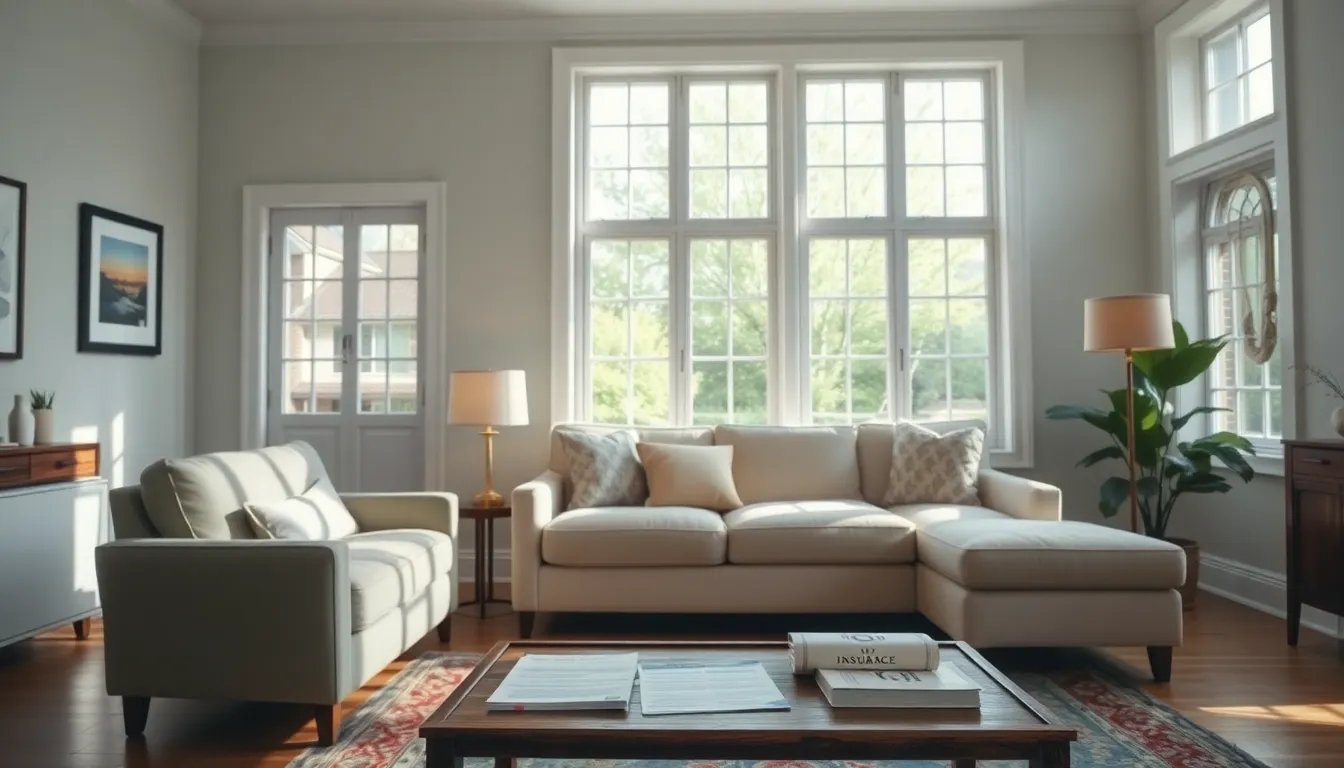Navigating the world of home insurance can feel like trying to find a needle in a haystack—if that needle were wearing a tiny top hat and dancing the tango. With various types of home insurance policies available, it’s easy to get lost in the jargon and options. But fear not! Understanding these types can save homeowners from headaches and financial heartaches down the road.
From basic coverage to more extensive options, each policy type offers unique benefits tailored to different needs. Whether you’re a first-time buyer or a seasoned homeowner, knowing the ins and outs of home insurance types can help you make informed decisions. So grab a cup of coffee, sit back, and let’s unravel the mysteries of home insurance—because who doesn’t want to protect their castle without losing their mind?
Table of Contents
ToggleOverview of Home Insurance Types
Home insurance comes in several types, each designed to address specific homeowner needs. The most common types include:
- HO-1: Basic Form
This policy covers a limited range of perils. It typically protects against named dangers such as fire, theft, and vandalism.
- HO-2: Broad Form
Broad Form policies offer more comprehensive coverage. They cover all the basic perils along with additional risks like falling objects and water damage from plumbing.
- HO-3: Special Form
HO-3 is the most popular type for homeowners. This policy provides open-peril coverage on the dwelling, protecting it against most risks. However, personal property is covered on a named peril basis.
- HO-4: Renters Insurance
This type caters to renters. It covers personal belongings and provides liability protection but does not cover the structure itself.
- HO-5: Comprehensive Form
HO-5 policies offer extensive coverage for both the home and personal property. They typically include more risks than HO-3 and have higher limits for personal belongings.
- HO-6: Condo Insurance
Designed for condominium owners, this policy covers personal property and any improvements made to the unit. It usually has fewer structural protections, relying on the condominium association’s insurance for building coverage.
- HO-7: Mobile Home Insurance
Insurance for mobile homes comes with specific coverage options. It addresses the unique needs of mobile properties while providing similar protections as standard homeowners’ policies.
- HO-8: Older Home Insurance
For homes older than a certain age, this policy takes into account the replacement cost of the structure. It uses actual cash value for claims, helping to cover the home’s historical value.
Understanding these types is crucial for homeowners determining the best fit for their individual situations. Selecting the appropriate type of home insurance helps ensure adequate protection against potential risks.
Basic Home Insurance Coverage

Basic home insurance coverage typically includes essential protection against common risks. Understanding the specifics can help homeowners select the most appropriate policy.
Actual Cash Value
Actual cash value (ACV) reflects the replacement cost of the property minus depreciation. This approach considers the current value of items, accounting for wear and tear over time. For example, if a roof installed five years ago suffers damage, the reimbursement covers only its depreciated value instead of the full replacement cost. Homeowners might find themselves underinsured due to this depreciation factor, which can lead to unexpected out-of-pocket expenses in the event of a loss. ACV works well for those looking for lower premiums but may not provide complete financial recovery in a disaster.
Replacement Cost
Replacement cost coverage provides reimbursement for the total cost to replace damaged property without deducting depreciation. In this scenario, if a homeowner’s television was stolen, her compensation would equal the cost to buy a new TV of similar type, regardless of its previous value. This policy type offers greater peace of mind, as it ensures homeowners can replace property effectively after a loss. While premiums may be higher than those for ACV, the value in protecting against financial losses attracts many homeowners. Referring to local insurance agents for tailored quotes remains a prudent step.
Types of Home Insurance Policies
Understanding the types of home insurance policies helps homeowners choose the best coverage for their needs. Below are the common policy types available.
HO-1: Basic Form
HO-1 offers minimal protection for homeowners. This policy typically covers a limited number of perils including fire, lightning, and theft. The coverage is basic and often insufficient for most homeowners, as it does not include a wide range of potential risks. Individuals looking for a low-cost option might find it appealing, but understanding its limitations is essential.
HO-2: Broad Form
HO-2 expands on the coverage of HO-1. This policy provides protection against a broader range of risks, including falling objects and water damage from plumbing issues. Homeowners benefit from this form due to its more comprehensive coverage compared to HO-1. It’s suitable for those seeking a balance between affordability and a higher level of security.
HO-3: Special Form
HO-3 serves as the most popular type of home insurance policy. It provides coverage for both the dwelling and personal property against all risks except those specifically excluded. This level of protection offers greater peace of mind for homeowners. Many opt for HO-3 due to its ability to safeguard against a wide array of potential hazards.
HO-4: Tenant’s Form
HO-4 caters specifically to renters who need coverage for personal belongings. This policy protects personal property against risks such as fire, theft, and vandalism. Renters benefit from this insurance as it helps cover losses that landlords typically do not insure. It’s a crucial option for individuals wanting to protect their possessions without insuring the entire dwelling.
HO-5: Comprehensive Form
HO-5 provides extensive coverage, resembling HO-3 but with fewer exclusions. This policy protects the home and personal property against a wide range of perils, with a focus on replacement cost. Homeowners appreciate its thorough coverage since it tends to include higher limits and additional protections. Many opt for HO-5 for its comprehensive nature, ensuring they’re well covered.
HO-6: Condo Form
HO-6 is tailored for condo owners, offering coverage specific to their needs. This policy protects personal property and provides liability coverage while addressing the unique requirements of condominium living. Owners of condominiums will find that this policy covers improvements made to the unit, an essential consideration. It’s vital for condo owners to understand their responsibilities in relation to their building’s master insurance policy.
Additional Coverage Options
Homeowners often seek additional coverage options to enhance their protection. Two important types to consider include flood insurance and earthquake insurance.
Flood Insurance
Flood insurance provides coverage for damage caused by rising water. Most standard home insurance policies exclude flood-related perils. FEMA offers flood insurance through the National Flood Insurance Program (NFIP), allowing policyholders to protect their homes against financial loss. Homeowners need to assess their risk based on location and consider this coverage, especially in flood-prone areas. Coverage limits under NFIP typically reach $250,000 for the structure and $100,000 for personal property. Purchasing flood insurance can protect against costly repairs and help ensure peace of mind during severe weather events.
Earthquake Insurance
Earthquake insurance provides protection against damage resulting from seismic activity. Standard home policies generally don’t cover earthquakes, making this additional coverage crucial in high-risk regions. Damage from earthquakes can range from foundation cracks to total structural failure, leading to substantial repair costs. Coverage typically includes the dwelling, personal property, and additional living expenses if temporary relocation is necessary. Policies can vary significantly in terms of deductibles and limits, so homeowners should evaluate their own needs carefully. Securing earthquake insurance can greatly mitigate financial harm in the aftermath of a tremor.
Navigating the world of home insurance can seem overwhelming but understanding the various types available makes it easier to find the right fit. Each policy serves distinct purposes and addresses specific needs that homeowners face. By considering factors like property type and personal circumstances homeowners can make informed decisions that protect their investments.
It’s essential to evaluate coverage options carefully and consult with insurance professionals to tailor policies to individual situations. Taking the time to understand the nuances of home insurance not only provides peace of mind but also ensures adequate protection against unforeseen events. With the right policy in place homeowners can confidently safeguard their homes and their financial futures.


